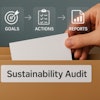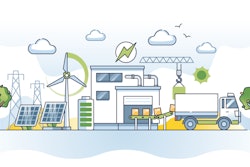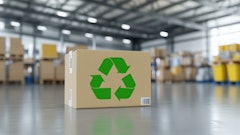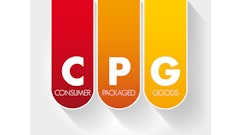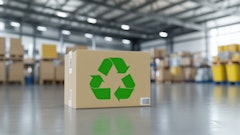
Packaging waste has grown to represent more than 40% of total waste produced in the U.S. and abroad.
The increase in packaging waste is attributable to a variety of factors, not the least of which is the rapid growth of eCommerce. Packaging plays a vital role in ensuring both protection and efficient shipment of goods, guaranteeing customer satisfaction throughout the purchasing journey. Convenience, safety concerns and mass customization also contribute to the packaging waste challenge.
Walk down any grocery aisle, and you’ll see a robust assortment of single-serving packaging and an expanded array of product sizes and formats. And while it’s been great for consumers and manufacturers, the impact of plastic, foam and film on our landfills is real.
As the need for better and more efficient ways to dispose of waste grows, so does the expense and resources needed to deal with it. Recycling alone is insufficient to manage packaging waste effectively. A successful plan also needs to include reducing overall packaging, compostable packaging and refillable packaging formants.
Good Intentions, Challenging Execution
There are over 9,000 different municipal recycling programs across the U.S. At the end of its useful life, packaging is either picked as part of the solid waste stream or separated for a municipal or private curbside recycling program. Recycled packaging ends up at one of the approximately 375 Material Recovery Facilities, or MRFs within the U.S. And while this is a good start, there are challenges that impede its execution. Despite the best intentions, some waste fails to reach these facilities for reasons ranging from the absence of a municipal recycling program to consumer apathy or confusion over what is recyclable. Moreover, more than 20% of the material that does make it to the MRFs cannot be recycled due to contamination. In addition, the processing capacity needed to handle the amount of packaging is 20 years behind the times. Most MRF’s need Investments in new technology and equipment just to keep up with the volume of today’s volume of packaging.
EPR is legislation that provides solutions and investment to mitigate the increasingly challenging objective of recycling waste. EPR legislation intends to transfer or shift the financial costs associated with recycling waste from the taxpayer to the producers or brand owners whose product is using the packaging. EPR legislation will provide the financial investment into the MRF infrastructure by creating a shared responsibility for the collection, recycling and processing of post-consumer packaging. As this legislation expands in the US, adjusting to EPR requirements will become increasingly challenging for manufacturers, food producers, brand owners, retailers, and e-commerce businesses.
A movement gaining momentum.
Long established in Europe, EPR laws are now in place in Canada, Asia, South America. As state and local governments weigh the expense and infrastructure needed to deal effectively with packaging waste, Extended Producer Responsibility is increasingly finding its way to legislative floors in the US as well. To date Maine, Oregon, California and Colorado have enacted EPR legislation, and more than thirty pieces of EPR legislation have been proposed nationwide in 2023 to mandate brand owners share in the responsibility for the entire lifecycle of their packaging.
While the details of the laws vary, Extended Producer Responsibility legislation shares three common goals to:
- Reduce overall packaging and packaging waste.
- Encourage, motivate and provide the ability for consumers to recycle while building financially healthy markets for recyclables.
- Make producers share the financial responsibility associated with recycling their packaging.
A Trend Fueled By Consumers
Consumers are increasingly looking for packaging options that are eco-friendly, recyclable and compostable. They want to know that the products they purchase and the packaging that is used, is not harming the environment.
EPR legislation addresses and provides solutions to public concern about packaging waste.
The recently released 2023 Buying Green Report reveals an interesting trend. Despite the substantial rise in consumer prices due to global inflation, there is a growing willingness among consumers to pay more for products packaged sustainably. 82% of respondents expressed their readiness to invest more in sustainable packaging—an increase of four points from 2022 and eight points since 2021. These findings send a powerful message: even amidst a worsening economic situation, the environment remains a top priority for consumers.
Who is Impacted by EPR?
EPR legislation will have the most impact on businesses involved in manufacturing or packaging products distributed through retail outlets or e-commerce to end users. The rule of thumb is, if packaging ends up in the consumers curbside trash or in recycling it will be included. Retailers can also be considered a “producer” if they private label a product whose packaging ends up in the consumer waste stream.
Packaging materials like single-use plastic, chipboard, corrugated cartons, and flexible films will fall within the scope of Extended Producer Responsibility coverage.
How will EPR Impact “Producers”?
In practice, manufacturers and distributors will pay a fee, or dues, based on the number of units they ship and the attributes of the packaging they use to present, preserve, protect, and transport their products (size, weight and material). A Producer Responsibility Organization or PRO collects the fees and works within the state to provide the local funding to increase the number of recyclables and recycling rates.
The level of government or stakeholder oversight varies by state. However, in most cases the PROs are responsible for administering EPR compliance, collecting funds, assisting producers with compliance, and providing technical assistance.
Compliance with the regulations can impact manufacturers in ways that impact their operations and profitability:
Operational Impact:
- Design Phase: EPR might necessitate changes in a product’s package design to make the packaging more recyclable or environmentally friendly. This can entail a shift in materials used, product structure and even the product’s overall functionality.
- Collection and Recycling Systems: Manufacturers might choose to set up their own systems to collect and recycle their packaging post-consumer. This could entail setting up return centers, coordinating with third-party recyclers, or establishing other collection mechanisms. This could be an alternative to a fee-based program should it be approved by a PRO.
- Supply Chain Adjustments: Depending on the materials required for a compliant design, manufacturers might need to adjust their supply chains. This could mean sourcing alternative materials or working with suppliers that adhere to certain environmental standards.
- Reporting: Manufacturers will need to track and report on their packaging to the PRO. They may also choose to conduct a life cycle analysis of their packaging.
Financial Impact:
- Increased Costs: Applying resources to reporting and supplier coordination, setting up collection, recycling, or disposal systems can be costly. Additionally, redesigning products or changing the supply chain can entail increased expenses.
- Fees and Penalties: Non-compliance might also result in fines.
How a Packaging Specialist Can Help:
The new legislation is complex and can vary by location, and businesses will experience some growing pains and risks as they learn to adapt. Working with a knowledgeable packaging partner to be prepared for these changes is essential. The right packaging partner can help producers understand the legislation and requirements and provide solutions to help keep EPR fees cost-neutral, to minimize the operational and financial impact of EPR legislation. There are several ways that a Packaging Specialist can help:
- Optimize Packaging for Sustainability: Packaging Specialists and their team of Packaging Engineers and Designers can audit existing packaging to recommend and optimize packaging to reduce the amount of material used and reduce cost, incorporate recycled or recyclable materials, and ensure packaging is compliant with EPR regulations.
- Facilitate Packaging Lifecycle Analysis: Evaluate the environmental impact of packaging from sourcing to disposal, to identify areas, and provide solutions for improvement.
- Help You Stay Updated on Legislation: Regulations can vary by region and can change over time. A Packaging Specialist can help keep track of relevant EPR legislation, ensuring manufacturers remain compliant.
- Cost-Effective Solutions: While sustainability is a primary goal, cost-effectiveness is crucial for any business. A specialist can balance both aspects, finding solutions that minimize environmental impact without significantly raising costs.
- Coordinate with Suppliers: Work with material suppliers to ensure they’re aligned with EPR requirements and provide the necessary sustainable materials.
As EPR legislation pushes manufacturers to adopt more environmentally friendly practices throughout their products’ lifecycle. A packaging specialist can be invaluable in helping manufacturers navigate these changes, balancing compliance with cost-effectiveness and operational feasibility.

